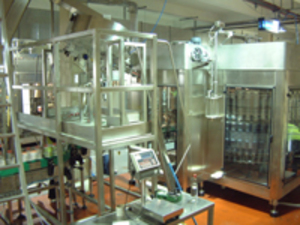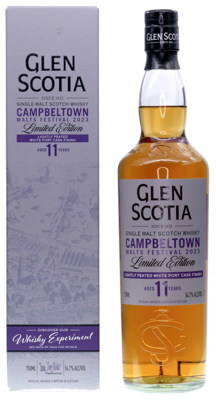|
|
Release Notes
Our favourite time of the year is almost upon us! In 2023 we’re celebrating the Campbeltown Malts Festival with a lightly peated 11 year old single malt scotch whisky, finished for 12 months in white port casks. It’s a dram fit for a celebration.
Glen Scotia
3rd Party Tasting Notes
Nose: Warming spiced stone fruit, almost like stewed white peach & cloves, with a fresher lemongrass and a slight mineral element.
Taste: Molasses, caramel sweetness with more prune and fig notes with waxed wood and sandalwood spice
Finish: Fills the mouth with a long fragrant finish
Taste: Molasses, caramel sweetness with more prune and fig notes with waxed wood and sandalwood spice
Finish: Fills the mouth with a long fragrant finish
Glen Scotia
The Distillery: Glen Scotia
| Established: 1832 |
| Silent since: False |
| Address: Campbeltown |
| → website |



The Glen Scotia distillery has been operating in the shadow of its more famous neighbour Springbank for almost two centuries. Well, I'm not really sure if Springbank was actually much more famous than Glen Scotia in the distant past, but it was true in the 1990's.
When I wrote the latest update of this distillery profile (March '09) Springbank had been mothballed for six months. When the news about the temporary closure arrived around half a year ago, they announced that Springbank would probably be closed for circa two years ago - but that was before the credit crisis hit Europe with full force in the autumn of 2008. It's conceivable that this will influence the plans of Springbank owners and possibly delay the reopening.
Anyway, let's get back to the history of Glen Scotia. That history started in 1832 when the Galbraith family founded the distillery. Glen Scotia remained in the family until 1919 when it was sold to West Highland Malt Distillers. Unfortunately, the company went bankrupt in 1924, after which Duncan MacCallum (a director of the company) took over Glen Scotia. The distillery was closed in 1928 and Duncan committed suicide by drowning himself in Campbeltown Loch - the lake that was especially created to serve as the water source of the distillery.
He wasn't the only Campbeltown distiller to feel the effects of politics on the other end of the Atlantic Ocean. Between 1920 and 1933 the United States suffered from the prohibition, during which the manufacture, transportation, import, export and sale of alcoholic beverages was illegal. Before the start of the prohibition, Campbeltown (the name of the town, but also of the surrounding region) was known as 'The Whisky Capital of the World'. During its heyday, more than thirty whisky distilleries were active in the Campbeltown region. These days, only two or three of these distilleries are still active.
One of the reasons for this sharp decline was the fact that most distilleries in the Campbeltown region had a strong focus on quantity instead of quality. Thanks to strong international demand (especially from the USA) the distilleries could easily sell their entire output, so there was little need to improve their whisky. This attitude proved to be a problem when the demand declined rapidly after prohibition was introduced in America and a big recession hit markets worldwide.
One of the first victims of the collapse of the whisky market was the (old) Glengyle distillery. This distillery was built around 1873 by William Mitchell after a fight with his brother John at the Springbank distillery. Glengyle was closed in 1925 and almost all other Campbeltown distilleries followed within a few years. However, after a slumber that lasted three quarters of a century, the Mitchell family (still owners of Springbank) revived Glengyle again in 2004.
Meanwhile, at Glen Scotia, malt whisky production was resumed in 1933... In 1954 the distillery was obtained by Hiram Walker, but it was sold on to A. Gillies & Co. within a year. Next, A. Gillies & Co. became part of Amalgated Distillers Products in 1970. Reconstruction occurred between 1979 and 1982, but Glen Scotia was closed again in 1984. Production started again in 1989 when ADP was taken over by Gibson International, before it stopped again in 1994 when it was taken over by Glen Catrine Bonded Warehouse Ltd. In 2000 staff from Loch Lomond distillery took over production at Glen Scotia.
In The New Millenium
When I wrote the latest update of this distillery profile (March '09) Springbank had been mothballed for six months. When the news about the temporary closure arrived around half a year ago, they announced that Springbank would probably be closed for circa two years ago - but that was before the credit crisis hit Europe with full force in the autumn of 2008. It's conceivable that this will influence the plans of Springbank owners and possibly delay the reopening.
Anyway, let's get back to the history of Glen Scotia. That history started in 1832 when the Galbraith family founded the distillery. Glen Scotia remained in the family until 1919 when it was sold to West Highland Malt Distillers. Unfortunately, the company went bankrupt in 1924, after which Duncan MacCallum (a director of the company) took over Glen Scotia. The distillery was closed in 1928 and Duncan committed suicide by drowning himself in Campbeltown Loch - the lake that was especially created to serve as the water source of the distillery.
He wasn't the only Campbeltown distiller to feel the effects of politics on the other end of the Atlantic Ocean. Between 1920 and 1933 the United States suffered from the prohibition, during which the manufacture, transportation, import, export and sale of alcoholic beverages was illegal. Before the start of the prohibition, Campbeltown (the name of the town, but also of the surrounding region) was known as 'The Whisky Capital of the World'. During its heyday, more than thirty whisky distilleries were active in the Campbeltown region. These days, only two or three of these distilleries are still active.
One of the reasons for this sharp decline was the fact that most distilleries in the Campbeltown region had a strong focus on quantity instead of quality. Thanks to strong international demand (especially from the USA) the distilleries could easily sell their entire output, so there was little need to improve their whisky. This attitude proved to be a problem when the demand declined rapidly after prohibition was introduced in America and a big recession hit markets worldwide.
One of the first victims of the collapse of the whisky market was the (old) Glengyle distillery. This distillery was built around 1873 by William Mitchell after a fight with his brother John at the Springbank distillery. Glengyle was closed in 1925 and almost all other Campbeltown distilleries followed within a few years. However, after a slumber that lasted three quarters of a century, the Mitchell family (still owners of Springbank) revived Glengyle again in 2004.
Meanwhile, at Glen Scotia, malt whisky production was resumed in 1933... In 1954 the distillery was obtained by Hiram Walker, but it was sold on to A. Gillies & Co. within a year. Next, A. Gillies & Co. became part of Amalgated Distillers Products in 1970. Reconstruction occurred between 1979 and 1982, but Glen Scotia was closed again in 1984. Production started again in 1989 when ADP was taken over by Gibson International, before it stopped again in 1994 when it was taken over by Glen Catrine Bonded Warehouse Ltd. In 2000 staff from Loch Lomond distillery took over production at Glen Scotia.
In The New Millenium
- 2000 - Some years after the ownership of Glen Scotia was transferred to Glen Catrine Bonded Warehouse Ltd. (who also owned the Loch Lomond distillery, as well as the defunct Littlemill distillery) their staff takes over production. The stills were actually fired up again for the first time by people from Springbank in 1999.
- 2005 - The old 14yo OB that had been available in the 1990's is replaced by a 12 years old official bottling.
- 2006 - a more heavily peated version of Glen Scotia is released as a 6 years old malt whisky, vintage 1999. That means that these stocks were laid down by the Springbank crew when they restarted the stills that year.
- 2007 - Another peaty expression of the Glen Scotia malt whisky was released in 2007 at an age of seven years.
- 2011 - the six washbacks at Glen Scotia are replaced by six new ones made out of stainless steel.
Trivia:
- After Glen Catrine took over the Glen Scotia distillery in 1994 it was mothballed for five years.
- During the 1990's Glen Scotia's 'standard' bottling was a 14 years old expression - a fairly unusual age. A twelve years old official bottling of the Glen Scotia malt whisky was released in 2005.
- Just like its neighbour Springbank, Glen Scotia is one of a few distilleries located in-between town buildings.
- For those of you that are planning a visit to (some of) the whisky regions of Scotland, Campbeltown may seem like an attractive destination because of its location relatively close to the airports Glasgow and Edinburgh. However, in reality it's quite a long journey along the Kintyre peninsula. So, it would be wise to spend the night in town. The highlight for me was spending a night in the hotel where Alfred Barnard had slept over a century ago.
- In 2007 Glen Scotia only produced circa 100,000 liters of alcohol - so they were operating far from their maximum capacity. This means that in recent years Glen Scotia has produced roughly the same amount of whisky as small distilleries like Bladnoch, Edradour and Kilchoman - the smallest distilleries in Scotland. In order to bring Glen Scotia on full steam again, it would seem that some financial injections are required. ) Things hadn't changed much in 2011; Glen Scotia still used less than 20% of its maximum capacity and only 130,00 litres of alcohol were produced.
from Malt Madness
The Owner: Glen Catrine Bonded Warehouse Ltd
| Established: 1974 |
| Silent since: False |
| Address: Laigh Road Catrine, Mauchline KA5, UK |
The group also own Loch Lomond Distillery (established circa 1814) which is a unique blend of the old and the new. Originally purchased in 1985 to ensure an adequate supply of malt whisky for the bottling plant, Glen Catrine have since invested in excess of £15.5 million in new Malt & Grain stills and new warehouses. It is currently the only distillery in Scotland that produces both grain and malt whisky on the same site. The average annual production is 10 million litres of grain alcohol and 2.5 million litres of malt alcohol, the equivalent of 43 million standard bottles of whisky every year. The average stockholding is in excess of 50 million litres of scotch whisky, making them the second largest family owned Distillery in Scotland. They also own two other distilleries, Glen Scotia and Littlemill. Glen Scotia, which resumed production in 1999, is one of only two Campbeltown Distilleries that remain in production. Being a privately owned family company, they seek to enter long-term relationships with their customers

Glen Catrine Bonded Warehouse Ltd. (established 1974), is now the largest independent bottling plant in Scotland, but was originally created to bottle whisky for their own chain of retail shops. Its current annual production is in excess of 36.5 million bottles of whisky, vodka, gin, rum and brandy. Amongst a multitude of brands, they produce the 5th highest selling whisky in the UK (High Commissioner Scotch Whisky) and the 2nd highest selling vodka in the UK (Glen"s Vodka). They also bottle Whisky, Rum, Brandy, Gin & Vodka for many of the leading "private" labels available in a variety of multiple retail outlets.

from Enterprise Tondelli
